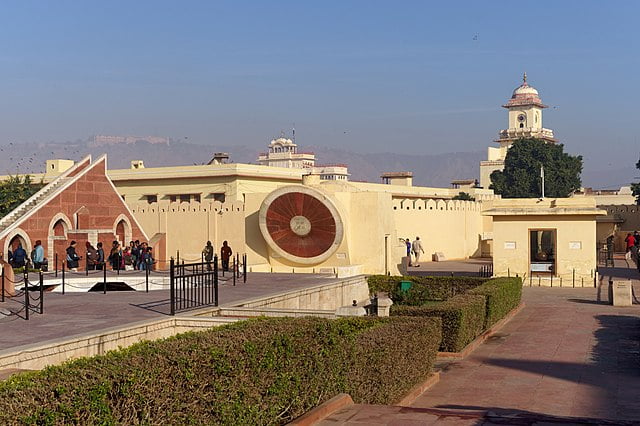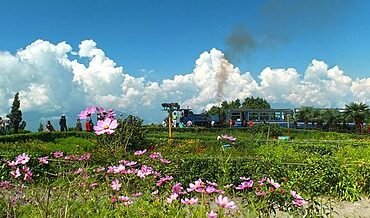If you are interested in astronomy and astrology, then you should visit the Jantar Mantar in Jaipur. It is a historic observatory that was built by Maharaja Sawai Jai Singh II, the founder of Jaipur, in the early 18th century. It is one of the most popular tourist attractions in Jaipur and a UNESCO World Heritage Site.
Jantar Mantar is located near City Palace and Hawa Mahal in Jaipur city. It is a collection of 19 astronomical instruments that are made of stone and marble. The instruments are designed to measure time, predict eclipses, track stars, and calculate horoscopes. The instruments are based on the Ptolemaic positional astronomy that was shared by many civilizations.
The instruments have names such as Samrat Yantra (the largest sundial in the world), Ram Yantra (a cylindrical instrument for measuring altitudes), Jai Prakash Yantra (a hemispherical instrument for locating celestial bodies), etc. visit during Jaipur Local Sightseeing and One day Trip From Delhi.
Jantar Mantar was built by Maharaja Sawai Jai Singh II, who was a keen astronomer and a patron of science. He was dissatisfied with the existing astronomical tables and wanted to create more accurate ones. He also wanted to reform the calendar and astrological predictions. He built five observatories in different cities, but the one in Jaipur is the largest and best preserved. He also compiled a new set of astronomical tables called Zij-i Muhammad Shahi, which were used in India for a century.
The observatory was used by the royal family and their courtiers for scientific and astrological purposes until the 19th century. It was also a place of learning and cultural exchange for scholars from different regions and religions. The observatory was damaged by natural disasters and human neglect over time. It was restored and renovated by the Rajasthan government and UNESCO in the 20th century. The observatory is now a museum that displays the instruments and their functions.
Here are some details about Jantar Mantar that will help you plan your visit.
Location of Jantar Mantar- Jaipur:

Jantar Mantar is located near City Palace and Hawa Mahal in Jaipur city. It is easily accessible by road, rail, or air.
Timing/Entry Fees Jantar Mantar- Jaipur:

Jantar Mantar is open from 9:00 AM to 4:30 PM on all days and there is an entry fee of INR 50 per person for Indian citizens and INR 200 per person for foreign citizens. There is also a fee of INR 10 for camera and INR 30 for video camera.
How to reach Jantar Mantar- Jaipur:
The nearest airport to Jaipur is Jaipur International Airport, which is about 13 km from Jantar Mantar. You can take a taxi or a bus from the airport to Jantar Mantar. The nearest railway station to Jaipur is Jaipur Junction, which is about 6 km from Jantar Mantar. You can take an auto-rickshaw or a cycle-rickshaw from the station to Jantar Mantar. Alternatively, you can also drive your own vehicle or hire a car from Jaipur or other nearby cities.
Things to do/Must see Jantar Mantar- Jaipur:

There are many things to do and see at Jantar Mantar. Some of them are:
- Explore the observatory and admire its architecture and design. The observatory has many instruments that showcase the astronomical skills and cosmological concepts of the Rajput rulers. You can also see the paintings, carvings, inscriptions, and sculptures that adorn the walls and pillars of the observatory.
- Learn about the functions and uses of the instruments with the help of guides or audio guides. You can see how the instruments measure time, predict eclipses, track stars, and calculate horoscopes. You can also see how the instruments operate in different celestial coordinate systems such as horizon-zenith, equatorial, and ecliptic.
- Visit the museum that displays more information about the history and significance of the observatory. You can see some models, charts, photographs, videos, and interactive exhibits that explain the scientific and cultural aspects of the observatory.
- Visit the nearby attractions such as City Palace, which is a splendid palace and museum complex; Hawa Mahal, which is a palace with hundreds of windows that allow breeze to enter; Jal Mahal, which is a palace floating on Man Sagar Lake; Nahargarh Fort, which is a hilltop fort that offers panoramic views of Jaipur; etc.
Significance of Jantar Mantar- Jaipur:

Jantar Mantar in Jaipur is not only a tourist attraction but also a place of great religious and historical significance. Some of the reasons why this place is important are:
- It is associated with Maharaja Sawai Jai Singh II who was a visionary ruler and a patron of arts and sciences. He was famous for his justice and wisdom and his stories are part of Indian folklore.
- It is one of the five observatories built by Maharaja Sawai Jai Singh II that showcase his scientific achievements and contributions to astronomy. These observatories are considered as architectural marvels and UNESCO World Heritage Sites.
- It is a place where scientific and astrological knowledge was advanced and disseminated among different regions and religions. It also reflects the cosmological worldview of Hinduism, Islam, Jainism, Buddhism, etc.
FAQ’s:
Q: When is the best time to visit Jantar Mantar?
A: The best time to visit Jantar Mantar is during the months of October to March when the weather is pleasant and comfortable.
Q: What are some tips for visiting Jantar Mantar?
A: Some tips for visiting Jantar Mantar are:
Avoid carrying valuables or expensive items as there may be crowds or pickpockets.
Follow the rules and regulations of the observatory authorities such as maintaining cleanliness or not littering.
Be careful while exploring the observatory as there may be sharp edges or slippery surfaces.
Respect the sentiments and beliefs of other visitors and do not disturb them.
Conclusion:
Jantar Mantar In Jaipur Is A historic observatory That was built by Maharaja Sawai Jai Singh II In The early 18th century It Is A collection Of 19 astronomical instruments That are made Of stone And marble The instruments are designed To measure time predict eclipses track stars And calculate horoscopes The instruments are based on The Ptolemaic positional astronomy That was shared by many civilizations The instruments have names such as Samrat Yantra Ram Yantra Jai Prakash Yantra etc If you are interested In astronomy And astrology You should definitely visit Jantar Mantar In Jaipur…










